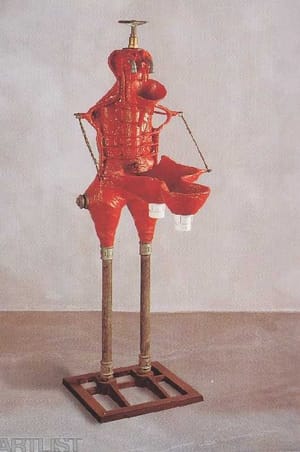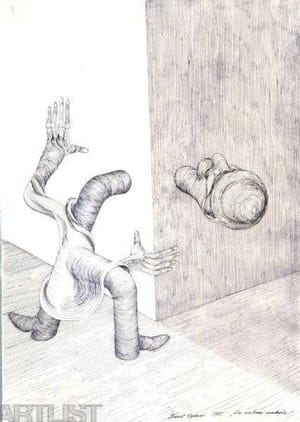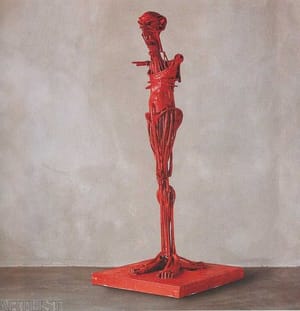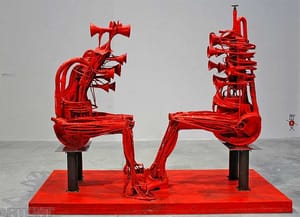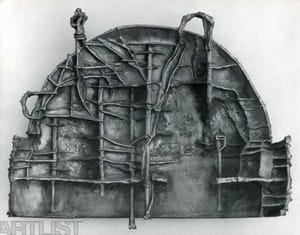- First Name
- Karel
- Surname
- Nepraš
- Born
- 1932
- Birth place
- Praha
- Website
- www.karelnepras.cz
- Died
- 2002
- Keywords
- CSU Library
- ↳ Find in the catalogue
About artist
Karel Nepraš began his studies at AVU in Prague in 1952 during the repressive Stalinist period. However, he soon found a circle of students (including Jan Koblasa, Bedřich Dlouhý and Jaroslav Vožniak) who resisted the pressure of the time and began to create their own world. There gradually arose a Dadaist-surrealist group of nonconformists, who reacted to the political situation with avowedly absurd initiatives, not only in art, but also in theatre, literature and music. The first such initiative (the first ‘malmuzherciád’) took place on 19 December 1954. Later, in 1957, the group was renamed the Šmidrové after the comic figure of the policeman from the children’s puppet film Kašpárkovy rolničky.
As one of the founders of the Šmidrové Group, during the 1950s Karel Nepraš focused on drawings filled with black humour. He was to continue to draw in a tragicomic, sarcastic spirit the whole of his life. At the end of the 1950s he took up sculpture. The two bronze figures entitled Standing / Stojících of 1959 were not simply an isolated phenomenon in his oeuvre, but an important gesture within the sculpture world at that time. Nepraš was not interested in developing classical sculptural principles, and both works were based more on the aesthetic of his drawings, in which he deformed grotesquely the forms of the figures. While one of the figures is created as a thin cylinder with a smooth surface, the body of the second opens expressively: it is ploughed through with a deep incision. This figure hints at the development of the next stage in Nepraš’s work, the period of the expressive textural treatment of materials that began shortly after 1960. These new sculptures were non-figurative and influenced by the wave of Czech informel artists of the Confrontations circle. They are expressively jagged and their content reacts to the Kafka-like world of hopelessness (Castle / Zámek, 1963-64, Portrait of Řehoř Samsa / Portrét Řehoře Samsy, 1964).
Around 1964 Nepraš discovered the world of assemblage. He created sculptures out of metaů, wire, hosepipe and other banal materials, which he supplemented with textile and smeared with paint (sometimes an aggressively red paint). His sculptures from the cycle Moroa, and the work entitled Large Dialogue / Velký dialog (1966) are among the highlights of Czech sculpture of the time. By linking wire elements, the artist created bizarrely deformed shapes in which the original material loses its legibility. The result is sinewy figures that provoke through their grotesque insistence. The humorous game with materials resonates not only with the aesthetic of parody and strangeness of the Šmidrové Group, but was also a response to the broader generational feeling of the absurdity of life.
After 1970 Nepraš continued to develop the technique of assemblage. Other materials and objects appear, such as various construction fittings, plumbing piles, metal springs, screws, vessels, metal and porcelain insulators, rubber hoses and other plumbing materials. A significant event was Nepraš’s participation in 1969 at the Symposium of Spatial Forms in Ostrava, where he discovered a new material: cast iron. However, he never gave up on the principle of structuring his work from individual parts. His cast iron sculptures, stark in tone, acquired movement: gears, cogs and toothed wheels (Figure with Filling / Figura s náplní, 1969-70, Figural Sculpture – For Walking / Figurální plastika – na šlapání, 1972, Attempted Suicide / Pokus o sebevraždu, 1976-77). Although there is a difference between his work of the 1960s and later works, a strongly grotesque inclination runs through the whole of his oeuvre and is instantly recognisable.
Over the next decades Nepraš worked on an aesthetic of assemblage using different technical materials and objects. Ceramic and porcelain appear more and more alongside metal. The artist moves from expressive figures (Fountain with Sink / Fontána s výlevkou, 1987) to minimalistic figures (Walking / Kráčející, 2000). Ironic hyperbole, expressive deformation and often black humour never disappear and change life into a joke, a joke that is an important element in survival (in each stage of the artist’s own life and that of society as a whole). Karel Nepraš created a very specific language of assemblage sculptures, grotesque figures, and these make him one of the most important representatives of the grotesque in the history of Czech art.
- Author of the annotation
- Ivona Raimanová
- Published
- 2014
CV
Studies:
1952-1957 Akademie výtvarných umění v Praze (sochařský ateliér prof. J. Laudy)
1948-1951 Státní odborná škola keramická, Praha
Pedagogical activities:
1992-2002 profesor, Akademie výtvarných umění v Praze
Awards:
2002 Státní vyznamenání za vynikající umělecké výsledky
1962 Stříbrná medaile, International Exhibition of Modern Ceramics, Praha
- Member of art groups included in ARTLIST.
Exhibitions
- Solo exhibitions
-
2012
Retrospektivní výstava DOX, Praha
2007
Dům umění,Zlín
2008
Galerie moderního umění vHradci Králové
2002
Galerie Benedikta Rejta vLounech
Letohrádek královny Anny
2001
„140" (s V. Šerákem)
K. N. Výběr z díla,Galerie výtvarného umění v Mostě
Soutoky a prameny I Zusammenflüsse und Quellen, Kunst Keller Kfingelputz, Kolín n. R. (s J. Steklíkem, A. Heinl, B. Pattersonem)
2000
Reifeisenbank, Praha Žižkov(s J. Načeradským)
Galerie Sokolovská 26, Ostrava
České centrum, Paříž
1999
Iron story, Galerie Peron, Praha
Nalakuj si sám, Galerie Gambit, Praha
České centrum, Drážďany (s J. Sopkem)
1998
Galerie Ve Dvoře, Veselí n. Moravou (s J. Steklíkem)
Galerie Ve Věži, Planá u Mariánských Lázní
1997
Karel Nepraš, Jiří Sopko, Jan Steklík, Dům umění, Zlín
1994
Karel Nepraš a Jan Steklík, KŠ,
Galerie Václava Špály, Praha,
Galerie Aspekt, Brno
1993
Míra zodpovědnosti, Galerie Behémót, Praha
1992
Sochy, Galerie hl. m. Prahy,
1991
Kresby, grafika, ilustrace, kreslený humor, České kulturní středisko,
Kresby, grafika, ilustrace, kreslený humor, drobná plastika, Národní galerie v Praze, Malá galerie, zámek Zbraslav
Klub Bohemia, Bratislava,
1988
Galerie Fronta, Praha(s K. Meisterem a J. Steklíkem)
1987
Kunstmesse Basilej (s J. Sopkem)
1985
Kresby, plastiky, KS Opatov, Praha
ÚMCH ČSAV, Praha (s J. Steklíkem)
1983
Plastiky, Kulturní dům, Dobříš (s. J. Sopkem)
1980
Plastiky, kresby, Galerie Sonnering, Münster
1972
Plastiky, projekty, kresby (s J. Steklíkem), Dům umění města Brno
1970
Račte točit, Špálova galerie, Praha, Malinův dům, Havlíčkův Brod
1969
Plastiky, grafika (s Naďou Plíškovou), Studio Generale, Stuttgart
1964
Plastiky, kresby, grafika,galerie na Karlově nám., Praha
- Group exhibitions not included in ARTLIST.
-
2004
/6Šedesátá / The sixties, Galerie Zlatá husa vPraze,Dům umění města BrnaGalerie uměníKarlovy Vary
Kupka - Nepraš: Setkání v architektuře, Galerie Jaroslava Fragnera,Praha
2005
Šmidrové: Jednou Šmidrou, Šmidrou na věky,Hrad Bítov, GalerieŠternberk, Atrium,Praha
2007
Karel Nepraš a přátelé, Alternativa,Zlín
Soustředěný pohled. Grafika 60. let ze sbírek členských galerií Rady galerií České republiky,OG v Liberci, OGV vJihlavě
2008
Neovladatelná vášeň pro krásu. Výstava k 70. narozeninám Vojtěcha Petratura, instalatéra, montéra, sběratele, galeristy a kurátora,Veselí nad Moravou
Česká plastika, Galerie Moderna,Praha
České a slovenské umění 60. let 20. století, Dům umění,Zlín,GVU v Ostravě
2009
Kupka - Nepraš: Setkání v architektuře, Nostický palác,Praha[3]
2010
New Sensitivity, National Art Museum of China,Beijing
Roky ve dnech. České umění 1945-1957,Městská knihovna, Praha
2000
Od nádoby k soše, Novoměstská radnice, Praha
1994
Prostor Zlín, Zlín
1992
Umění akce, Mánes, Praha
1991
Tradition und Avantgarde in Prag, Galerie Pravis, Osnabrück
Český informel, Galerie hlavního města Prahy
Křižovnická škola čistého humoru bez vtipu, ČMVU v Praze
1990
Inoffiziell, Museum der Stadt Regensburg
Polymorphie, Martin Gropius Baue, Berlín
Quarante artistes Tchéques et Slovaques, Galerie La Defénse, Paříž
Praha - Paříž, Mánes, Praha
1988
Grotesknost v českém výtvarném umění 20. století, GHMP, Praha
Salón 88, PKOJF, Praha
Museum of Art, Cornell University, Ithaca, New York
Barevná plastika, Vojanovy sady, Praha
Humor 88, Nové Město na Moravě
Humor 88, Hradec Králové
Architektura a socha, soutěž na sídliště Barrandov, Galerie J. Fragnera, Praha
Forum 1988, Pražská tržnice, Praha
Čsl. sochařství od r. 1945, Varšava
1987
Veletrh umění, Basilej
K pražskému kulturnímu létu, Lidový dům, Praha-Vysočany
Expressiv, Muzeum 20. století, Vídeň
1985
Barevná plastika, Galerie H, Kostelec nad Černými lesy
1984
Česká kresba 20. století, Musée national d`art moderne Centre Georges Pompidou, Paříž
Oblastní galerie výtvarného umění v Olomouci
Česká kresba 20. století ze sbírek OGVU, Olomouc
Česká kresba 20. století ze sbírek AJG, Hluboká nad Vltavou
1981
Eleven contemporary artists from Prague, Michigan University, Rackham Galerie Ann Arbor, Michigan
1980
Eleven contemporary artists from Prague, New York University, New York
1978
Christchurch Art Festival International of Drawings, Christchurch, Nový Zéland
1975
Muzeum umění, Lodž
1973
Sochár a príroda, Socha piešťanských parkov, Piešťany
1971
České sochařství 20. století,Umjetnička galerija Bih Sarajevo
1970
České umění co. století, Orangerie des Schlosses Charloteenburg, Západní Berlín
III. Exposicion international del pequenó bronce escultores Europes, Museo Espanol de Arte Contemporaneo, Madrid
1969
Arte contemporanea in Cecoslovacchia, Galeria Nazionale d`Arte Moderna, Řím
Nová figurace, Mánes, Praha,
Dům umění, Brno
Socha a město, Liberec
7 mladých českých malířů a sochařů, Galerie Lambert, Paříž
1968
Výstava československého umění, Frankfurt nad Mohanem
Výstava současného československého umění, Kunstforreningens Hus, Kodaň
Československé sochařství od Myslbeka k dnešku, Rodinovo muzeum, Paříž
„Šmidrové", Špálova galerie, Praha
Současné československé umění, Antverpy, Brusel
„Lyrika průhledné noci", českoslovenští surrealisté, Kunstamt, Berlín, Wilmersdorf
1967
Výstava současného československého umění, Torino
Jeden okruh volby, Okresní muzeum v Písku
České umění, Kunstforum, Göhrrde, Kiel
Bilance, výstava plastiky, Olomouc
9. bienále současné plastiky,Middelheim, Antverpy
6 prerni international dibuix Joan Miró, Barcelona
17 českých umělců, Galerie Orez, Haag
1966
Umělecká beseda, Mánes, Praha
Výstava mladých (AICA),Výstavní síň Čs. spisovatele, Praha
Výstava mladých (AICA), Mánes Praha
Výstava československého umění,Akademie umění, Západní Berlín
Výstava drobné plastiky, Madurodam, Haag
Moravská galerie, Brno
1965
„Šmidrové", Ostrov nad Ohří
1964
Umělecká beseda a hosté, Mánes, Praha
Muzeum moderního umění, Paříž
Mladá česká avantgarda,
IV. Bienále mladých,
Galerie Lambert, Paříž
Europahaus, Vídeň
Divadlo Za branou, Praha
„D", Nová síň, Praha
Castello Spagnolo
Alternative attuali, L`Aquuilla,
1962
Mezinárodní výstava keramiky v Praze
Mezinárodní výstava keramiky v Buenos Aires
1957
Výstava na jeden večer („Šmidrové"), Střelecký ostrov Praha
- Collections
-
Národní galerie v Praze,
Alšova jihočeská galerie Hluboká nad Vltavou,
České muzeum výtvarného umění v Praze,
Galerie hlavního města Prahy,
Moravská galerie v Brně,
Galerie výtvarného umění v Ostravě,
Galerie výtvarného umění v Olomouci,
Galerie moderního umění Hradec Králové,
Východočeská galerie Pardubice,
Galerie výtvarného umění Cheb,
Galerie umění Liberec,
Galerie B. Rejta Louny,
Galerie umění Litoměřice,
Galerie umění Zlín,
Libraiy of Congress Washington,
Museum Sztuki Lodž,Musée d`art Moderne Paris,
Museum Bochum
Gema art, Praha
- Other realisations
Architectural and public space realizations:
2005
Odhalen Pomník Jaroslava Haška (dokončen dcerou Karolínou Neprašovou) bronz- Praha, Žižkov
1996
Dveře "Paláce Myslbek" (bronz) - Praha, Staré město
1994-8
Patníky před Toskánským palácem (kámen) - spolupráce s arch. Pavlem Kupkou - Praha, Hradčany
1994
Dialog VIII., Zlín (porcelán, železo)
1993
Patníky před Lichtensteinským palácem (litina) a balustrády schodišťové haly (kámen) - spolupráce s arch. Pavlem Kupkou - Praha, Malá strana
1988
Kameraman (Barrandov, litina)
1985
Altán v parku domova důchodců v Malešicích v Praze (litina)
1968
Praha (ulice Na Můstku) reliéf "Kancelářské stroje" hliník - realizace v 90. letech zničena
Poutač na krejčovský salón ("Šatičky") (ve spolupráci s arch. Vlado Miluničem a ak.soch. Kurtem Gebauerem)
Symposiums:
1998
Sympozium litiny, Třinec
Sympozium k roku 2000, Greiz
Bronzové sympozium, Brno
Sympozium kameniny, Břeclav
1996
Světlo, stín a porcelán, 5. mezinárodní sympozium v Lounech
1994
Prostor Zlín
Workshop der Stadt Traun
1993
Sympozium prostorových forem, Ostrava
1990
Sochařské sympozium Lemberk
1971
Keramické sympozium v Uherském Hradišti
Symposium urbanum Norimberk (SNR), umělci nebyl povolen výjezd z republiky
1969
Sympozium prostorových forem v Ostravě
Fordovo stipendium (USA), umělci nebyl povolen výjezd z republiky
1968
Artchemo v Pardubicích
1965
Keramické sympozium v Gmündenu (Rakousko)
Monography
- Monography
2012
Karel Nepraš. Praha: DOX Prague, 2012
2005
Šmidrové, Sborník, ed. Koblasa J, Jirousová V, NPÚ v Brně, Fontána, Olomouc
2004
Kupka – Nepraš: Setkání v architektuře, Horyna M a kol., G J. Fragnera, Praha
2002
V. Šlajchrt, Neprašova škola hrou, Respekt, č. 16.
D. Ž. Bor (V. Zadrobílek),Umění cesty - cesta umění, Tvar, č. 10.
Ludvík Ševeček: Karel Nepraš a Zlín. Prostor Zlín,
IX., 2002, O. 1 - 3, s.40 -43.
Jan Rous: Karel Nepraš: Sedící Stojící Kráčející.
Úvodní text katalogu výstav, Pražský hrad - Belveder, Ed. Gema Art, 2002.
Magdalena Juříková: Kalu Neprašovi (2.4.1932 - 5.5.2002). Ateliér, 2002, č. 11, s. 3.
Ataliér, 2002, č. 23, číslo ěnované Karlu Neprašovi
(Marie Klimešová: Karel Nepraš pod zemí
Karel Nerpaš ... život jde přes nás, rozhovor Ivana Jirouse s Karlem Neprašem
Věra Jirousová: Souchy jsou našimi souputníky.
Rozhovor redakce Ateliéru s Karlem Neprašem.
Rozhovor redakce Ateliéru s Kamilem Bahbouhem.
Eva Petrová: Spojité výstavy.
1997
M. Nešlehová, Poselství jiného výrazu,
base - ArtFakt, Praha.
Ludvík Ševeček: Setkání Karla Nepraše, Jiřího Sopka a Jana Steklíka ve zlínském Domě umění. Prostor Zlín, 1997, V., Č. 2, s. 2 -5.
1995
O. Hanel, Mým ředitelům, Ateliér, č. 1.
1994
I. S. (Ivo Sedláček): Karel Nepraš, Dialog VIII.
In: Prostor Zlín 1994. Sborník 2. ročníku Výtvarného sympozia, Státní galerie ve Zlíně 1994, s.24.
Ludvík Seveček: Ke zlínské výstavě Karla Nepraše.
Prostor Zlín, 1994, II., s. 3.
1993
V. Jirousová, Míra zodpovědnosti, Ateliér č. 2.
I.š. (Ludvík Ševeček): Karel Nepraš.
Prostor Zlín 1993,1., Č. 7 - 8, s. 8n.
1991
I. Jirous, Divnost, že vůbec jsme, Ateliér č. 23 (text z r.1972).
Eugen Brikcius, Neprašovo chrlení.ohádky. In: E. Brikcius: Vyložení umělci aneb kunsthistorické pohádky
Nakl. Inverze, Praha 1991, S. 67-84.
1990
Josef Kroutvor: Karel Nepraš a česká groteska,
Výtvarné umění, č. 5.
1988
Jindřich Chalupecký: Nové umění v Čechách (samizdat, 1994 vydalo H&H Praha).
1987
Jiří Šetlík: Cesty po ateliérech 1977-1987 (samizdat)
1984
Evžen Brikcius: Neprašovo chrlení,
Obrys, č. 2, Můnchen.
1979
Josef Kroutvor: Škola české grotesky (samizdat).
G. Benamou: L`art aujourd´hui en Tchécoslovaquie, Paris
1975
Jan Kříž: Karel Nepraš, Terzo occhio
Bologna, nr., 1.
1970
Jan Kříž: Šmidrové, Obelisk, Praha.
Luděk Novák: Nová figurace, Obelisk, Praha.
Nouveau Dictionnaire de la Sculpture Moderne,
Edition Hazan, Paris.
Ivan Jirous: Otakar Slavík - Karel Nepraš
Výtvarná práce, č. 8.
1968
B. Mráz, Šmidrové, Výtvarná práce, č. 12/13.
L. Novák, K estetice současného sochařství,
Výtvarné umění, č. 1.
1967
Udo Kulterman: Neue Dimensionene der Plastik,
Ernst Wamuth Tubingen.
J. Kříž, Estetika divnost, Výtvarné umění, č. 1.
Z. Felix, Dnešek mladé generace,
Výtvarné umění, č. 2.
1965
Z. Felix, Křižovatka mladé generace, Výtvarné umění, Č.7.
F. Šmejkal, Krize a východiska, Výtvarná práce, č. 10/11.
J. Šetlík, Socha 1964, Výtvarné umění, č. 2.
L. Novák, Osudy generace, Výtvarné umění, č. 6/7.
B. Mráz, Postsurrealistický okruh pražské umělecké školy, Výtvarné umění 6/7

